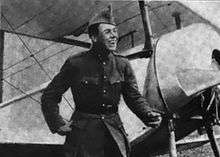Victor Chapman
| Victor Chapman | |
|---|---|
 Chapman in 1916 | |
| Birth name | Victor Chapman |
| Born |
April 17, 1890 New York, New York, U.S. |
| Died |
June 24, 1916 (aged 26) Douaumont, France |
| Buried at | Meuse-Argonne American Cemetery and Memorial |
| Allegiance | USA/France |
| Service/branch | Aviation/Infantry |
| Years of service | 1915-1916 |
| Rank | Sergeant |
| Unit | Lafayette Escadrille |
| Awards | Medaille Militaire, Croix de Guerre with two Palms. |
Victor Emmanuel Chapman (April 17, 1890 – June 24, 1916) was a French-American pilot remembered for his exploits during World War I. He was the first American pilot to die in the war.
Growing up
Chapman was born in New York City to essayist John Jay Chapman and Minna Timmins (who died in 1898). He and his father moved to France soon after. In France, Chapman obtained dual-citizen status as a French and US citizen.[1]
His father re-married, to Elizabeth Chanler, a sister of William A. Chanler from the Astor family and Dudley–Winthrop family, when Chapman was a teenager. Chapman returned to the United States in his late teens to attend Harvard University. After graduating, Chapman returned to Europe, spending time in France and in Germany.
Fighting in the war
When World War I broke out, his father and stepmother moved to London, England. However, Chapman decided to stay in France, joining the French Foreign Legion on August 30, 1914, and served in the 3rd March regiment of the Legion. He became friendly with four men during his days on the trenches: a Polish fighter who was known only as "Kohl", and Americans Alan Seeger, Henry Fansworth, and David King. The trio of Americans watched as Kohl was killed by a bullet while walking with his friends.
After Kohl's death, Chapman and two other friends, (Norman Prince and Elliot Cowdin), were given an opportunity to fly in a fighter airplane. Chapman requested transfer to the Aéronautique Militaire, the army's air arm. He attended flight school and was certified as a pilot.
Chapman flew many missions for the 1st Aviation Group and was commissioned a sergeant. He was chosen as one of the founding members of N.124, the Escadrille Americaine, also known as the Lafayette Escadrille. On June 17, 1916, he was flying over the Verdun sector when he was attacked by four German airplanes. During the engagement, Chapman suffered a head wound, most likely from an attack by then four-victory German flier Walter Höhndorf.[2] Chapman landed his airplane safely, with Höhndorf getting his fifth victory as a result. While recovering Chapman found out that his friend, Clyde Balsley had been wounded in a separate incident. Prior to his last flight Chapman put loaded oranges onto his aircraft, intending to take these to Balsley who was in hospital recuperating from his wounds.[3][4] Chapman was attacked north of Douaumont by German flying ace Leutnant Kurt Wintgens, a close friend of Höhndorf. With Wintgens flying a Halberstadt D.II that day against Chapman's Nieuport 16, Wintgens soon gained the upper hand.
Awards and medals
Chapman earned many medals and commendations during his military career. Chapman was interested in the arts and in writing. He often found inspiration to write while he was in the middle of battles, and many of the letters he sent to his father were written in these circumstances. A book of these letters, called Letters from France, was published after his death. In his memory, the composer Charles Martin Loeffler, a friend of Chapman's father, composed his quartet Music for Four Stringed Instruments.[5] He was buried at the Meuse-Argonne American Cemetery and Memorial in France[6] and a cenotaph in his honor was erected in St. Matthew's Episcopal Churchyard, Bedford, New York.[7]
Bibliography
- Chapman, Victor Emmanuel; Chapman, John Jay (1917). Victor Chapman's letters from France, with memoir. New York: The Macmillan Company.
References
- ↑ Thomas, Lately. A pride of lions: the Astor orphans, W. Morrow, 1971.
- ↑ van Wyngarden, G. Early German Aces of World War 1. Oxford: Osprey Publishing, 2006. p. 57 ISBN 1-84176-997-5
- ↑ McConnel, James Rogers (1917). Flying for France : with the American escadrille at Verdun. Doubleday, Page & company. p. 42.
- ↑ McKenzie, Fred Arthur (1917). Americans at the front. New York: George H. Doran Company. p. 17.
- ↑ Bruce Gbur, booklet to Naxos CD 8.559077 including a recording of Loeffler's "Music for Four Stringed Instruments"
- ↑ Victor Emmanuel Chapman at Find a Grave
- ↑ Victor Emmanuel Chapman at Find a Grave
- Guttman, Jon Nieuport (2006). Flyers of the Lafayette, Albatros Productions, ISBN 1-902207-78-5